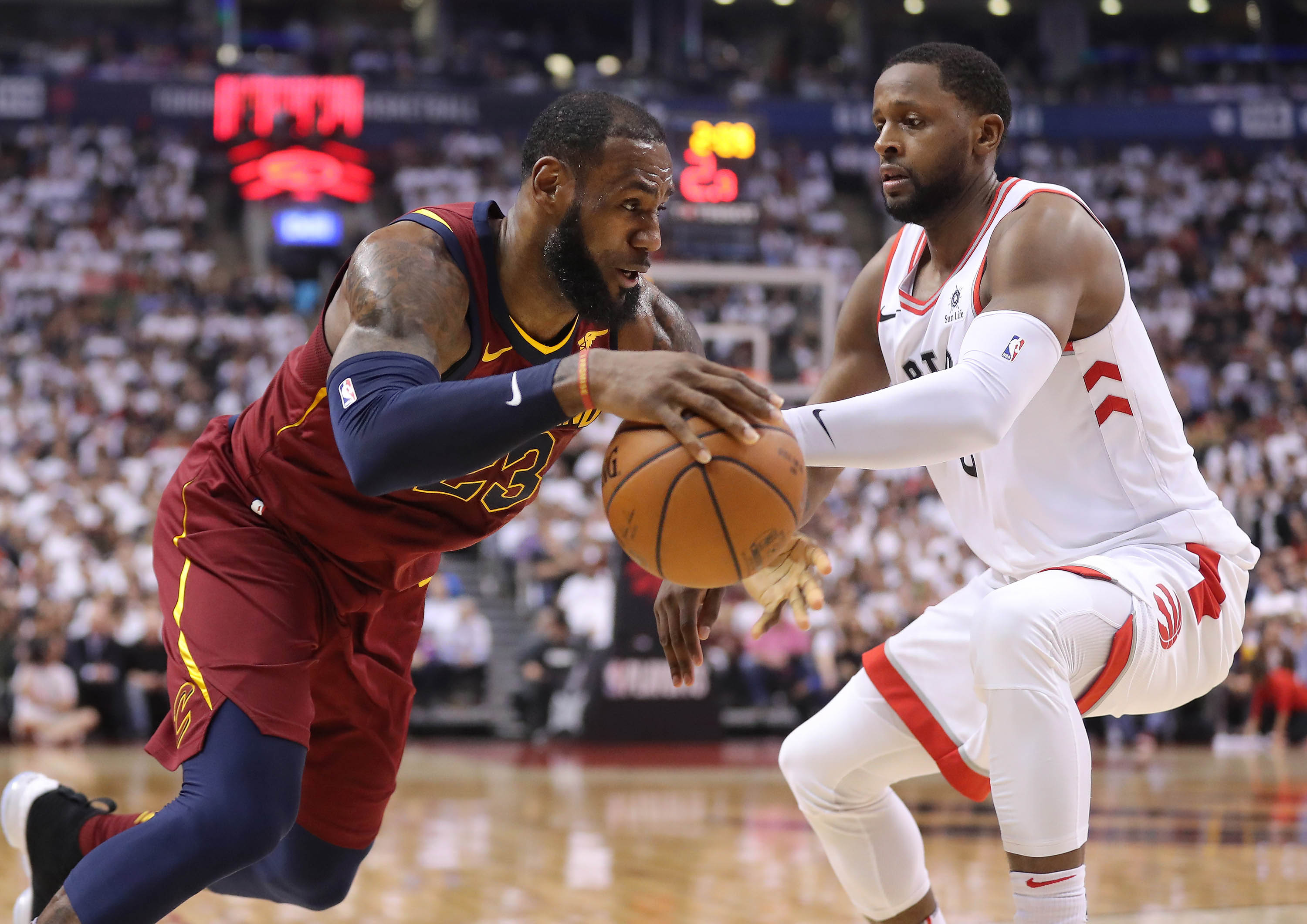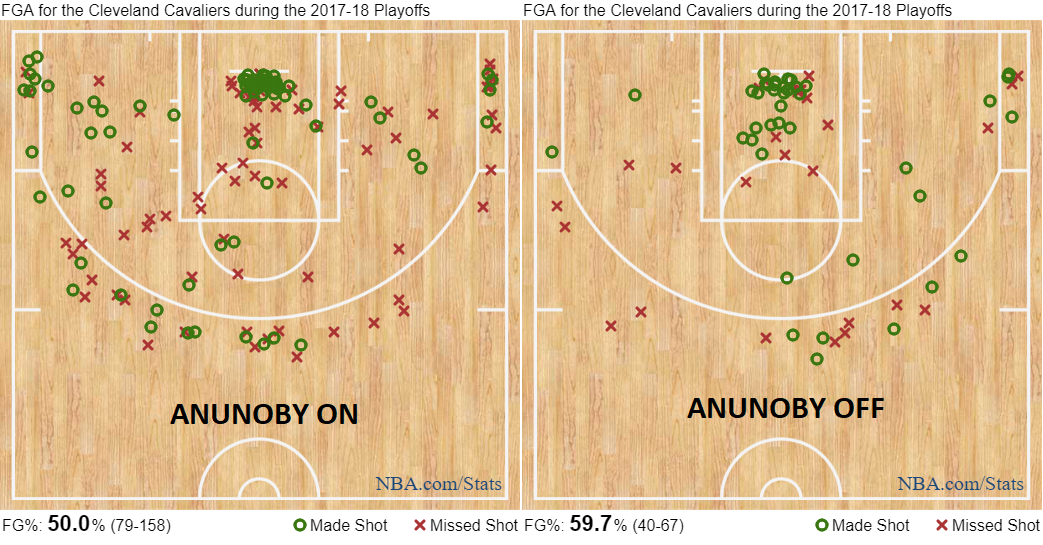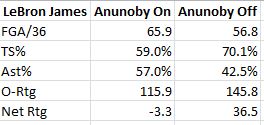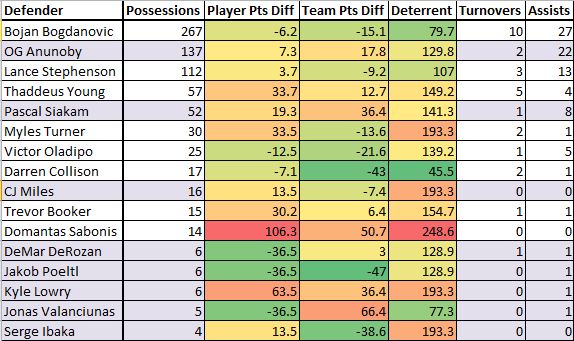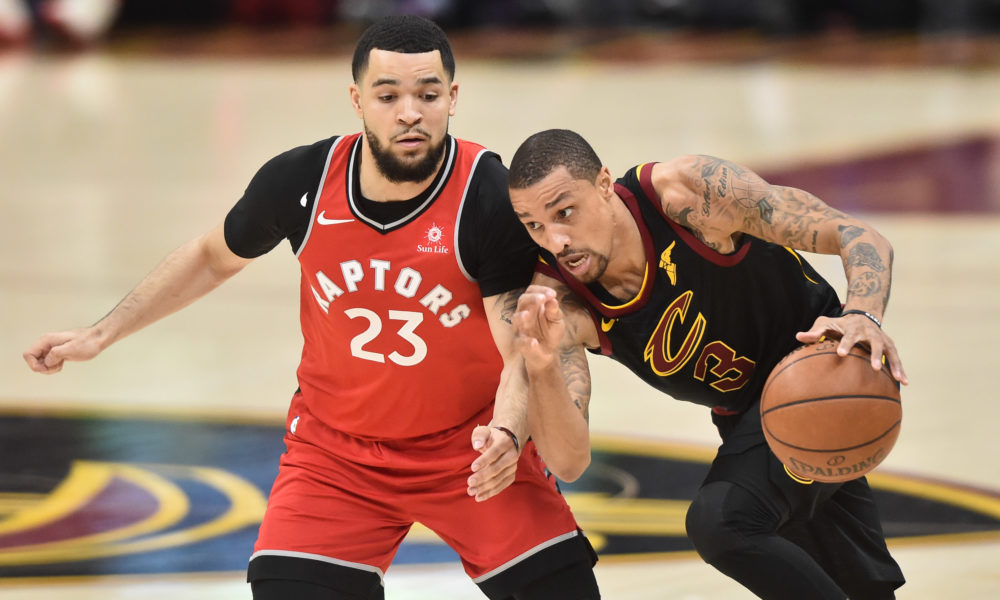The Toronto Raptors are a switching defense, and LeBron James, Kevin Love, and Tyronn Lue are acutely aware.
In general, Toronto’s aim is to guard the 1-5 pick-and-roll with just two players, with the big dropping back and the guard trailing over the top of the screen. The intention is to goad mid-range and high-paint looks while cutting off the rim and preventing easy pocket passes to the roll man, and it’s been generally effective – Toronto was a high-end defense all season, completely extinguished Washington’s corner threes in the first round (they were punished a bit by above-expectation mid-range shooting, mind you), and the Raptors have been only a slightly below-average pick-and-roll defense through nine playoff games against tough competition in that regard. It’s telling that Jonas Valanciunas, ostensibly the team’s defensive weak link, owns the team’s best individual defensive rating in the postseason; it’s not necessarily actions involving the center that have been problem.
Around those primary pick-and-rolls, though, things have been more complicated for Toronto. The Raptors are a switch-heavy team at every non-center position, and their base strategy is to switch a lot of action one-through-four both on and off the ball. Off the ball, this has led to some miscommunications that free a cutter or a shooter because Toronto gets caught making a tough decision with screening shooters or simply mis-executes. Kyle Korver and Love are having a pretty nice time. None of what Cleveland has been running is new, and the Raptors, while likely prepared, have struggled to stop it. Before the series, I outlined a number of key sets to watch for – a corner offense with Love and George Hill screening for each other while James surveys the floor, an empty-side Hill-Love pick-and-roll, the play, the old Matthew Dellavedova-Richard Jefferson action the Cavaliers scored with on 14 consecutive possessions in the 2016 Eastern Conference Finals, and so on – and each has haunted Toronto at times. (There was also the end-of-game trap execution, which, yeah.)
In other words: There are any number of areas the Raptors could be cleaning up to have swung a tight series more in their favor. This is always the case in a playoff series. The Cavaliers surely have a list of things they’d like to be doing better so as to not require James heroics. There’s also the specter of whatever the Raptors did better, James doing even more in response. And I know for some, looking at the granular points when down 0-3 in a series is almost moot, because it’s unlikely it matters from here. Still, if the Raptors want to make this a series, get it back home, maybe make Cleveland work, then there are a number of areas they can clean up to help reach that end.
One of them is over-switching. Again, the strategy calls for switching on the perimeter in general, but the Cavaliers got surgical in Game 3 attacking Toronto switches knowing they were coming. Cleveland’s used them to get Love mismatches in the post when Valanciunas is off the floor all series, and on Saturday they used them to get LeBron James attacking.
This has been less of an issue when OG Anunoby is on the floor. The Raptors have been adamant that they want to guard James one-on-one without sending help and freeing shooters and cutters, and they’ve mostly been able to do that with the rookie on the floor. (Well, the staying one-on-one part; they’ve done a poor job sticking with shooters and cutters regardless.) James has become more of a passer and jump-shooter when guarded by Anunoby, and he’s gotten to the free-throw line far less.
This is unrelated but look at Anunoby’s performance!
Heading into games on May 7, here's how all NBA rookies have fared in TPA throughout the 2018 playoffs: pic.twitter.com/kaXrXCcjMk
— NBA Math (@NBA_Math) May 7, 2018
Indiana’s strategy was similar, and they stuck to a fairly strict no-switching approach, dialing up the physicality denying the ball and on the catch. Bojan Bogdanovic had a really nice defensive series despite James’ scoring, and he was able to help force turnovers by fronting the post entirely (Anunoby has mostly three-quartered it and aimed to tip entry passes, as the Raptors don’t want to have to send baseline help if the pass gets over top of a cheating Anunoby cleanly). James had his way with some Pacers defenders, but the degree to which he’s attacked every non-Anunoby Raptors defender is notable.
In Game 3, James relentlessly hunted switches on to C.J. Miles, as an example. Miles is a below-average defender but has at least been one of Toronto’s most consistently effortful performers on that end, and he’s actually had some successful possessions against James. He attacked DeMar DeRozan, too, and to his credit DeRozan had a few strong defensive stands (the inconsistency there is maddening; he’s clearly capable of defending well when locked in). It’s telling, though, that the Cavaliers know ahead of time they’ll be able to draw the switch and are seeking it with such regularity. Here’s the same chart for Love, from my piece at The Athletic yesterday linked above.
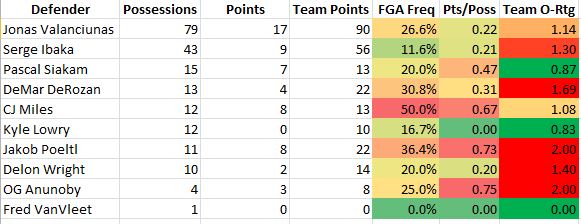 James has run a number of pick-and-rolls with Hill, and the Hill-Love actions that should have worried Toronto heading in have been troublesome. Love-Korver off-ball actions have hurt, too. (Korver has taken 10 threes classified as “wide open” in the series and six more with a defender only within four-to-six feet; only three of his 19 attempts beyond the arc. Want a snapshot of how simple shot-making has impacted this series versus the Indiana one? Korver shot 43.7 percent on those open threes against the Pacers and is at 56.3 percent here. As a team, Cleveland has gone from 33.9 percent to 44.4 percent on those looks.) A lot of this is communication – which shouldn’t really be an issue given the switching assignments have been fairly consistent – some of it is personnel, and some of it is the Cavaliers just being really good and difficult to account for.
James has run a number of pick-and-rolls with Hill, and the Hill-Love actions that should have worried Toronto heading in have been troublesome. Love-Korver off-ball actions have hurt, too. (Korver has taken 10 threes classified as “wide open” in the series and six more with a defender only within four-to-six feet; only three of his 19 attempts beyond the arc. Want a snapshot of how simple shot-making has impacted this series versus the Indiana one? Korver shot 43.7 percent on those open threes against the Pacers and is at 56.3 percent here. As a team, Cleveland has gone from 33.9 percent to 44.4 percent on those looks.) A lot of this is communication – which shouldn’t really be an issue given the switching assignments have been fairly consistent – some of it is personnel, and some of it is the Cavaliers just being really good and difficult to account for.
When Anunoby is on the floor, Toronto has at least been able to stay mostly committed to guarding James one-on-one, but they haven’t done a good enough job around him to prevent James from simply working as a quarterback and waiting for defensive mistakes to exploit. When Anunoby’s not on the floor, James has attacked whomever, either sizing up Pascal Siakam or drawing a quick switch. There’s not an easy answer here, because it’s James. The Raptors could go under screens and dare a red-hot James to keep shooting pull-up jumpers, which is probably worthwhile if he’s seeking out certain mismatches. They could also work to make sure they don’t have multiple minus defenders on the court at once for him to attack, though they’re not exactly flush with two-way threats. Some of it is just fighting through screens harder and not conceding the switch as soon as it’s initiated (there’s not even resistance on some of these, especially off the ball).
In general, the Raptors have done a better job in this series than in recent years. It’s been a very close series, by just about any way of looking at it other than “3-0.” And there’s a genuine improvement in the primary area the Raptors thought they needed to get better in for this matchup. The entire focus of their culture reset was on the offensive end of the floor, and their top-five offense from the regular season has completely carried over to the postseason for the first time. They’re actually scoring a fragment of a point more per-100 possessions despite the Wizards being a roughly average defense, the Cavaliers stepping up their play a bit on that end (Love has been super under-rated on that end when it’s not Lowry attacking him, by the way).
It’s on defense where Toronto has slid, though, and a strategy that served them incredibly well over 82 games is in need of some recovery. You can’t stop everything against the Cavaliers, and even within their base strategy the Raptors are just making mistakes they could iron out, but the Cavaliers have clearly found a soft spot they want to attack, and they’ll likely do so again in Game 4 if it’s there.

